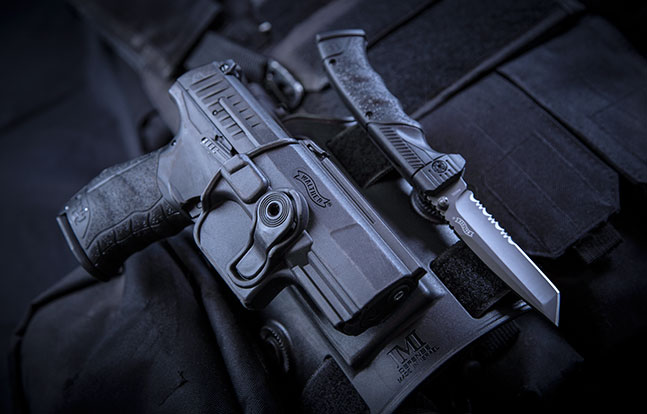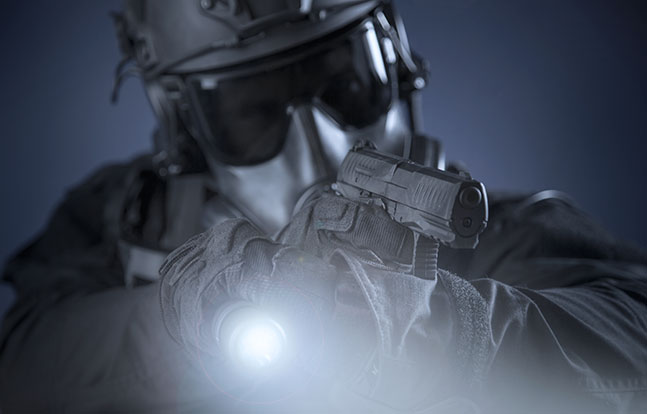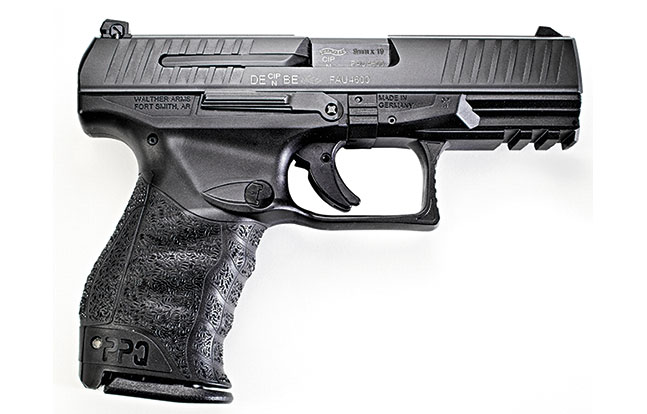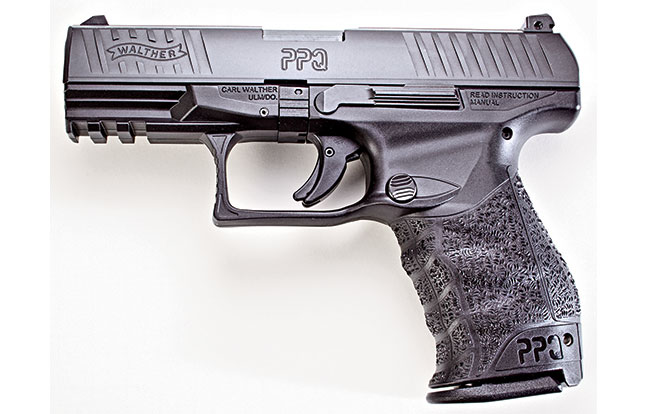My first duty pistol as a full-time law enforcement officer—specifically as an undercover Ohio Liquor Control investigator—was a blued Walther PPK/S in .380 ACP. At the time, the Walther PPK was not available in the U.S. since it did not meet the ATF’s importation point system due to its short grip. The PPK/S was importable because it utilized the longer grip of the Walther PP, which added an additional round to the magazine over the PPK along with an additional ounce of weight, allowing it to pass the standards.
RELATED: Top 10 Features of the Walther PPQ M2 Pistol
I loved my PPK/S. Reliable, easy to carry and slimmer than a five-shot .38 Special with more rounds on tap, it served me well both at Liquor Control as well as for my first few months working undercover for the narcotics division at the Metropolitan Enforcement Group in Licking County, Ohio. I carried it until I decided a larger-caliber pistol was in order and upgraded to a Star PD .45. The Walther PPK/S was the only Walther product I’d ever owned or shot until I had a chance to test the new 9mm Walther PPQ M2.
Advertisement — Continue Reading Below
Weighing in at only 24 ounces because of its sculpted-polymer frame with a 15-round magazine capacity, the compact-sized, 4-inch-barreled, 9mm PPQ M2 exudes German engineering and renowned Walther quality. As soon as I removed the PPQ M2 from the box, I knew it was a pistol with exceptional quality and features ideal for law enforcement use.
Gun Details
The PPQ M2 ships with two steel magazines with bumper pads. The steel slide has both front and rear serrations for grasping, and both the slide and barrel are treated with Tenifer, an invisible surface treatment that resists corrosion. The PPQ M2’s low-profile, three-dot sights are made of polymer and adjustable for windage only. They are well defined and quick to pick up. The slide release is easily accessed by the shooting thumb; it’s ambidextrous, unobtrusive and operates smoothly. The system is a definite plus for those of us who use the slide release lever to speed up our reloading process.
Advertisement — Continue Reading Below
The PPQ is striker-fired, with no external hammer and without the manual decocker button found on the Walther P99 due to the “Quick Defense” safety lever trigger system. The Quick Defense trigger is absolutely superb, just like the company’s literature claims. It has a short travel of only 0.4 inches with a 0.1-inch reset distance. It is very crisp and enhances the accuracy potential of the PPQ M2. It is probably the best striker-fired trigger of this type that I have ever handled.
“As soon as I removed the PPQ M2 from the box, I knew it was a pistol with exceptional quality and features ideal for law enforcement use.”
Also, unlike the Teutonic lever-style magazine release of the P99—which is positioned as part of the triggerguard, something most American shooters aren’t used to—the PPQ M2 has a traditionally styled magazine release button mounted on the grip frame that is large, round and easily accessed. My sample pistol came with it mounted on the left side for right-handed shooters, but it can be changed to the right side for left-handed shooters in seven short steps with a screwdriver and a punch. Pushing in straight on the button causes the magazine to release easily. Its operation during testing was flawless.
Advertisement — Continue Reading Below
The triggerguard itself is a throwback to the 1980s in that it is checkered on its face and very slightly recurved. This style is designed for a previously in-vogue gripping technique where the weak support-hand index finger was placed on the triggerguard. The only thing this technique did was to pull shots to the left for a right-handed shooter firing with two hands. Going with a smaller and rounded triggerguard would have kept the PPQ M2 a tad more in line with current firearms operational thought, but in any event the design doesn’t hurt anything.
There is a Picatinny rail molded into the dust cover for attaching lasers, lights or a combination of both. To assist in making this pistol fit the user like a glove, there are a total of three backstraps included—sizes small, medium and large—to adjust the grip size. The PPQ is shipped with the medium backstrap mounted on the pistol, and it turned out to be the perfect fit for me. I didn’t try the other sizes because I couldn’t improve on the feel of the medium grip.
Since the PPQ M2 is almost a mid-sized pistol in terms of outside dimensions but still possesses a full-size feel, it seemed good to test it in a holster designed strictly for concealment. Kinetic Concealment offers a new IWB rig known as the Hybrid that is made from Kydex and leather, like many tuckable holsters in vogue with a number of different manufacturers. But the Hybrid has a special feature. The leather backing of the holster is lined with wetsuit neoprene for comfort against bare skin. This is a nice touch. While the plain leather-backed holsters work great, I have found that as I get older, I like to work with gear that adds to my comfort, even by small degrees. The neoprene backing adds just a tad more comfort when wearing the rig over long periods of time. It’s also nice to see that Kinetic Concealment had a Kydex sheath already available for a relatively new pistol like the PPQ M2. Not everyone does. I found that there was enough leather to protect the muzzle from direct contact with the skin, and the PPQ stays entirely out of sight, whether a shirt is worn untucked over the rig or tucked in beneath the belt clips. The retail price for the Hybrid is a reasonable $76.95.
Advertisement — Continue Reading Below
I also outfitted the PPQ M2 with a Streamlight TLR-2 HL light/laser. The TLR-2 HL features an eye-scorching 630-lumen output and can be used in either of three modes: laser only, light only, or laser and light. I wanted to get a feel for firing the PPQ M2 with and without the TLR-2 attached to the frame.
Range Time
I headed to the range with the Walther PPQ M2, my chronograph and a variety of 9mm loads in hand: aluminum-cased Blazer 115-grain FMJs, Speer Gold Dot 124-grain JHPs, Wilson Combat 115-grain XTP JHPs and 115-grain Winchester “white box” FMJ ammo. I am a real fan of the 9mm for all the right reasons—low recoil, excellent accuracy, high magazine capacity, reasonable cost and, with modern ammo, more than adequate downrange effectiveness. Working with the PPQ M2 made me even more of a 9mm fan. Shooting the PPQ M2 with the TLR-2 light/laser attached balanced the pistol even more and dampened the already low recoil further.
Advertisement — Continue Reading Below
I did nothing to prepare the PPQ M2 before shooting—I ran it straight from the box. Every round tested ran with absolute smoothness in terms of feeding, cycling and ejecting. The PPQ M2’s ergonomics make it a very fun shooter that is also capable of some very fine accuracy. I was rewarded with a 1.5-inch, five-shot group at 21 feet comprised of two clusters of bullet strikes. I wasn’t really trying—it all fell together quite naturally—partly because of the great ergonomics and partly because of the outstanding trigger.
Even though not marked as a +P load on the box or cartridge case itself, the velocity champion turned out to be the Wilson Combat XTP load, with an average of 1,353 feet per second (fps) and a deviation between fastest and slowest rounds of a mere 3 fps! Wilson’s ammo is truly precise and some of the most consistent stuff I have tested to date. The slowest load was the Blazer aluminum-case FMJ round with an average velocity of 1,208 fps. The best groups from the Speer, Wilson and Winchester rounds were between 1.75 and 2 inches at 21 feet.
Convinced of the PPQ M2’s close-range capabilities, I wanted to see how the accuracy would hold up at 100 yards, firing from a two-handed, unsupported, standing position. The PPQ M2’s crisp sights and excellent trigger pull made it possible to get five shots within the silhouette target at that distance. One round landed above the target’s left shoulder, about 2 inches outside of the silhouette. To me, that kind of accuracy means the pistol will be just fine at any distance less than that. In short, the PPQ M2 passed my test with flying colors.
Advertisement — Continue Reading Below
Working with and testing the Walther PPQ M2 pistol was a great experience. In a world with what seems to be “cookie cutter” polymer-framed 9mm pistols on the market, the Walther PPQ M2 is a standout for the law enforcement market. It sets new standards for what striker-fired 9mm pistols destined for duty use should be.
For more information, visit waltherarms.com or call 479-242-8500.































